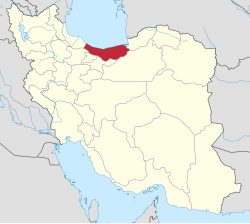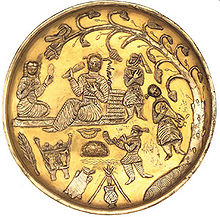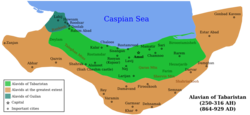
A | B | C | D | E | F | G | H | CH | I | J | K | L | M | N | O | P | Q | R | S | T | U | V | W | X | Y | Z | 0 | 1 | 2 | 3 | 4 | 5 | 6 | 7 | 8 | 9
Mazandaran Province
| |
|---|---|
 Location of Mazandaran Province within Iran | |
| Coordinates: 36°23′N 52°11′E / 36.383°N 52.183°E[2] | |
| Country | Iran |
| Region | Region 1[1] |
| Capital | Sari |
| Counties | 22 |
| Government | |
| • Governor-general | Yousef Nouri |
| • MPs of Assembly of Experts | 1 Ali Moalemi 2 Norallah Tabresi 3 Sadeq Larijani 4 Seyed Rahim Tavakol 5 Seyed Sadegh Pishnamazi |
| • Representative of the Supreme Leader | Mohammad Bagher Mohammadi Laeeni |
| Area | |
| • Total | 23,833 km2 (9,202 sq mi) |
| Population (2016)[4] | |
| • Total | 3,283,582 |
| • Density | 140/km2 (360/sq mi) |
| Time zone | UTC+03:30 (IRST) |
| ISO 3166 code | IR-02 |
| Main language(s) | Mazandarani(Tabari)[5] |
| HDI (2017) | 0.845[6] very high · 4th |
Mazandaran Province (Persian: استان مازندران; )[a][b] is one of the 31 provinces of Iran. Its capital is the city of Sari.[7] Located along the southern coast of the Caspian Sea and in the adjacent Central Alborz mountain range, the province is in the central-northern part of the country. Mazandaran, founded in 1937, covers an area of 23,842 km2.[8][9]
At the time of the 2006 National Census, the province had a population of 2,893,087 in 783,169 households.[10] The following census in 2011 counted 3,073,943 people in 931,007 households.[11] At the most recent census in 2016, the population had risen to 3,283,582 in 1,084,798 households.[4] Mazandaran is one of the most densely populated provinces in Iran.[12]
The province has diverse natural resources, notably large reservoirs of oil and natural gas.[13] The diverse natural habitats of the province include plains, prairies, forests and rainforest[14] stretching from the sandy beaches of the Caspian Sea to the rugged and snowcapped Alborz sierra,[15] including Mount Damavand, one of the highest peaks and volcanoes in Asia.[16]
Mazandaran is a major producer of farmed fish,[17] and aquaculture provides an important economic addition to traditional dominance of agriculture.[18] Another important contributor to the economy is the tourism industry, as people from all of Iran enjoy visiting the area.[19] Mazandaran is also a fast-growing centre for biotechnology.[13]
Etymology
Literally "the gate or the valley of the giants" from مازن (mâzan) + در (dar) + ـان (ân), from Avesta (Avestan: 𐬨𐬀𐬰𐬀𐬌𐬥𐬌𐬌𐬀, romanized: mazainiia, lit. 'giant'). The name has been used in Shahnameh to refer to a land inhabited by divs or (daevas) and sorcerers and is difficult to conquer.
In Mazandaran, there are places named Div Asiyab, Div Cheshmeh, Div Kela, Div Hamam, etc.
History

Human habitation in the area dates back at least 75,000 years.[20] Recent excavations in Gohar Tape in Rostamkola provide proof that the area has been urbanized for more than 5,000 years, and the area is considered one of the most important historical sites of Iran.[21] It has played an important role in cultural and urban development of the region.[22] Mazandaran is one of the oldest areas without a significant nomadic heritage, thus culturally sedentary.
Indigenous peoples of the region include the ethnic Mazanderanis,[23] who speak an Iranian language which most closely resembles Gilaki and Sangiseri language, but also has phono-typical similarities to several Caucasian languages, reflecting the history of the region and its peoples.
In the early 20th century, Reza Shah connected northern Elbourz to the southern slopes by constructing seven new roads and railways, the provinces of Mazandaran and Gilan became known as Shomal by all Iranians (meaning "the North" in Persian). Mazandaran is a Caspian province in the north of Iran.[24] Located on the southern coast of the Caspian Sea, it is bordered clockwise by Russia (across the sea), Golestan, Semnan, Tehran, Alborz, Qazvin, and Gilan Provinces. Sari is the largest city and the capital of Mazandaran province.
Mazandaran Province was made part of the Region 1 upon the division of the provinces into five regions solely for coordination and development purposes on June 22, 2014.[1]



Pre-Islamic history
| Part of a series on the History of Tabaristan |
|---|
 |
|
|
Before the arrival of the Iranian-speakers to Iran, native people of this area were subsistence hunters and cattle herders. Archaeological studies in caves belt and Hutu man in Behshahr in the Mazandaran date to ca. 9500 BCE. The Amard were a tribe living along the mountainous region bordering the Caspian Sea, including current day Amol. Tapuri[25] were a tribe in the Medes south of the Caspian Sea mentioned by Ptolemy and Arrian.[26] Ctesias refers to the land of Tapuri between the two lands of Cadusii and Hyrcania.[27]

The territory known as Mazandaran has changed hands among various dynasties from early in its history. There are several fortresses remaining from the Parthian Empire and Sasanian Empire, and many older cemeteries scattered throughout the province. During this era, Mazandaran was part of Hyrcania, which was one of the important provinces.
In 662 CE, ten years after the death of Yazdegerd III, the last Sasanian emperor, a large Muslim army under the command of Hassan ibn Ali invaded Tabarestan.
With the advent of the Sasanian Empire, the King of Mazandaran (Tabaristan and Padashkhwargar) was Gushnasp,[28] whose ancestors had reigned in the area (under the Parthian empire) since the time of Alexander the Great. In 529–536, Mazandaran was ruled by the Sasanian prince Kawus, son of Kawadh.[28] Anushirawan, the Sasanian king, defeated Zarmihr, who claimed his ancestry from the legendary blacksmith Kaveh.[28] This dynasty ruled the area till 645 AD, when Gil Gilanshah (a descendant of the Sasanian king Jamasp and a grandson of Piruz) joined Mazandaran to Gilan.[28]
In 651 the Sasanid Empire fell, and all of the Sasanid domains gradually came under Arab control, except for the Caspian region of Iran (among which Tabaristan).
Islamic history
Tabaristan maintained an existence independent of the Umayyad Caliphate which supplanted the Sasanian Empire in the early seventh century, with independent Zoroastrian houses like the Bavand and Karen fighting an effective guerilla warfare against the Ummayads. A short-lived Alid Shiite state collapsed before the subsequent take-over by the Ziyarid princes. During the post-Islamic period the local dynasties fell into three classes: local families of pre-Islamic origin; the ʿAlid sayyid; and local families of secondary importance.[28]

The Karinids claimed descent from Karin, brother of Zarmihr who was the pre-Islamic ruler under the Sasanians.[28] Their last representative Mazyar was put to death in 839.[28]
In the 9th-11th century AD, there were repetitively military raids undertaken by the Rus' between 864 and 1041 on the Caspian Sea shores of Iran, Azerbaijan, and Dagestan as part of the Caspian expeditions of the Rus'.[29] Initially, the Rus' appeared in Serkland in the 9th century traveling as merchants along the Volga trade route, selling furs, honey, and slaves. The first small-scale raids took place in the late 9th and early 10th century. The Rus' undertook the first large-scale expedition in 913; having arrived on 500 ships, they pillaged the westernmost parts of Gorgan as well as Mazandaran and Gilan, taking slaves and goods.

The Bavandids, who claimed descent from Kawus, provided three dynasties.[28] The first dynasty (665–1007) was overthrown on the conquest of Tabaristan by the Ziyarid Kabus b. Wushmgir.[28] The second dynasty reigned from 1073 to 1210, when Mazandaran was conquered by 'Ala al-Din Muhammad Khwarzamshah.[28] The third ruled from 1237 to 1349 as vassals of the Mongols.[28] The last representative of the Bavandids was killed by Afrasiyab Chulawi.[28]
The Paduspanids claimed descent from the Dabuyids of the north.[28] They came to prominence around 660 and during the rule of the ʿAlids were their vassals. Later, they were vassals of the Buyids and Bavandids, who deposed them in 1190.[28] The dynasty, restored in 1209–10, survived until the time of Timur; the branch, claiming descent from Kawus the son of Kayumarth reigned until 1567 and the other, that of Iskandar the son of Kayumarth, until 1574.[28]
In the Safavid era (1501–1736) Mazandaran was settled by very large numbers of Georgians, Circassians, Armenians, and other Peoples of the Caucasus, whose descendants still live or linger across Mazandaran. Towns, villages and neighbourhoods in Mazandaran still bear the name "Gorji" (i.e., Georgian) in them, although most of the large amounts of Georgians, Armenians, and Circassians are already assimilated into the mainstream Mazandaranis. The history of Georgian settlement is described by Iskandar Beg Munshi, the author of the 17th century Tarikh-e Alam-Ara-ye Abbasi, and both the Circassian and Georgian settlements by Pietro Della Valle, among other authors.[30]
Tabaristan remained independent until 1596, when Shah Abbas I, Mazandarani on his mother's side, incorporated Mazandaran into his Safavid empire, forcing many Armenians Circassians, Georgians, to settle in Mazandaran. Pietro della Valle (1586–1652), who visited a town near Firuzkuh in Mazandaran, noted that Mazandarani women never wore the veil and didn't hesitate to talk to foreigners. He also noted the extremely large amount of Circassians and Georgians in the region, and that he had never encountered people with as much civility as the Mazandaranis.
Today, Persia proper, Fars, Mazanderan on the Caspian Sea and many other lands of this empire are all full of Georgian and Circassian inhabitants. Most of them remain Christian to this day, but in a very crude manner, since they have neither priest nor minister to tend them.
Post-Safavid period
After the Safavid period, the Qajars began to campaign south from Mazandaran with Agha Mohammad Khan who already incorporated Mazandaran into his empire in 1782. On 21 March 1782, Agha Mohammad Shah proclaimed Sari as his imperial capital. Mazandaran was the site of local wars in those years, which led to the transfer of the capital from Sari to Tehran by Fath Ali Shah. In Modern era at Mazandaran make new house and bridge in Amol and Sari. In along the beach and in the forest built Villa and modern settlements.
Before the reign of Nader Shah, the province was briefly occupied by the Russian army in the aftermath of the Russo-Persian War (1722–23) and returned to Persia in 1735. Following the outcomes of the Russo-Persian War (1804–13) and the Russo-Persian War (1826–28) northern Iran, especially Mazandaran and Gilan, as well as, to a certain extent, Tehran, fell under a growing Russian sphere of influence.[citation needed]
In the 19th century, during the reign of Fath-Ali Shah Qajar, the verdant region of Mazandaran was paid due attention as a recreational area.
The top provincial official referred to the existence of three international airports and three major sea ports in the province and the visit of millions of Iranian and foreign tourists to Mazandaran, including health tourists.
Geography

Text je dostupný za podmienok Creative Commons Attribution/Share-Alike License 3.0 Unported; prípadne za ďalších podmienok. Podrobnejšie informácie nájdete na stránke Podmienky použitia.
Antropológia
Aplikované vedy
Bibliometria
Dejiny vedy
Encyklopédie
Filozofia vedy
Forenzné vedy
Humanitné vedy
Knižničná veda
Kryogenika
Kryptológia
Kulturológia
Literárna veda
Medzidisciplinárne oblasti
Metódy kvantitatívnej analýzy
Metavedy
Metodika
Text je dostupný za podmienok Creative
Commons Attribution/Share-Alike License 3.0 Unported; prípadne za ďalších
podmienok.
Podrobnejšie informácie nájdete na stránke Podmienky
použitia.
www.astronomia.sk | www.biologia.sk | www.botanika.sk | www.dejiny.sk | www.economy.sk | www.elektrotechnika.sk | www.estetika.sk | www.farmakologia.sk | www.filozofia.sk | Fyzika | www.futurologia.sk | www.genetika.sk | www.chemia.sk | www.lingvistika.sk | www.politologia.sk | www.psychologia.sk | www.sexuologia.sk | www.sociologia.sk | www.veda.sk I www.zoologia.sk









